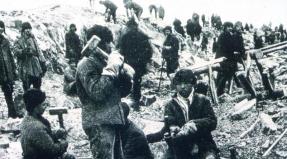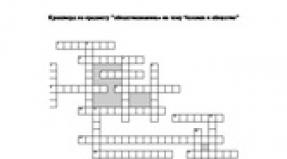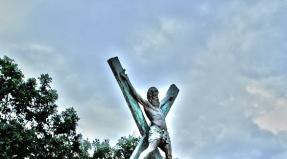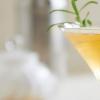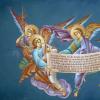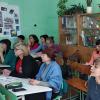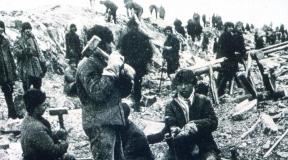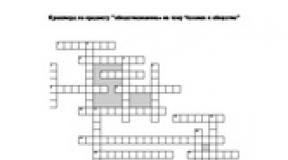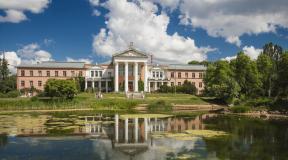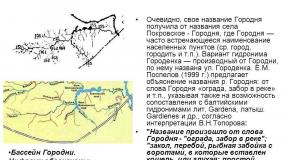Molecular physics (lesson development). Lecture notes on physics for secondary vocational education.doc - Lecture notes on physics for secondary vocational education Lesson plans in physics on the portal Notes
LECTURE NOTES
Natural Science (PHYSICS)
in the specialty of SPO 38.02.01.
"Economics and accounting (by industry)"
Full-time form of education)
Teacher: Demenin L.N.

Vladivostok
2018
2

Explanatory note
This work program in physics is based on:
Federal component of the state educational standard
basic general education. approved by order of the Ministry of Education of the Russian Federation No. 1089
dated 03/05/2004.
programs G.Ya. Myakisheva (Collection of programs for general education
institutions: physics 10 11 classes / N.N. Tulkibaeva, AE Pushkarev. – M:. Education.
2006).
The program of secondary (complete) general education (basic level) is designed for
41 hours
The material corresponds to the approximate program for secondary (complete) physics
general education (basic level), mandatory minimum maintenance,
recommended by the Ministry of Education of the Russian Federation.
The study of physics at a basic level is aimed at achieving the following goals:
mastering knowledge about the fundamental physical laws and principles underlying
the basis of the modern physical picture of the world; the most important discoveries in the field
physicists who had a decisive influence on the development of engineering and technology; methods
scientific knowledge of nature;
mastering the skills of observing, planning and executing
experiments, put forward hypotheses and build models, apply acquired knowledge on
physics to explain various physical phenomena and properties of substances;
practical use of physical knowledge;
development of cognitive interests, intellectual and creative
abilities in the process of acquiring knowledge and skills in physics using
various sources of information, including modern information means
technology; formation of skills to assess the reliability of natural science
information;
fostering confidence in the possibility of knowing the laws of nature;
using the achievements of physics for the benefit of the development of human civilization;
the need for cooperation in the process of jointly performing tasks, respectful
attitude towards the opponent’s opinion when discussing problems of natural science
3

content; readiness for a moral and ethical assessment of the use of scientific achievements,
sense of responsibility for protecting the environment;
use of acquired knowledge and skills to solve practical problems
tasks of everyday life, ensuring the safety of one’s own life.
The study of the physics course in 1011 classes is structured on the basis of physical
theories as follows: mechanics, molecular physics, electrodynamics, optics,
quantum physics and elements of astrophysics.
Requirements for the level of student preparation:
As a result of studying physics, a student should know:
meaning of concepts: physical phenomenon, hypothesis, law, theory, substance,
interaction, electromagnetic field;
the meaning of physical quantities: speed, acceleration, mass, force, impulse, work,
mechanical energy, internal energy, absolute temperature, average
kinetic energy of matter particles, amount of heat, elementary electrical
charge;
the meaning of the physical laws of classical mechanics, universal gravitation,
conservation of energy, momentum and electric charge, thermodynamics;
contribution of Russian and foreign scientists who had the greatest influence on the development
physicists;
Be able to
:
describe and explain physical phenomena and properties of bodies: movement
celestial bodies and artificial satellites of the Earth; properties of gases, liquids and solids;
electromagnetic induction, propagation of electromagnetic waves; wave properties
Sveta; emission and absorption of light by an atom; photoelectric effect;
distinguish
hypotheses from scientific theories;
draw conclusions based on
experimental data; give examples to show that: observations and
experiments are the basis for putting forward hypotheses and theories and allow testing
the truth of theoretical conclusions; physical theory makes it possible to explain
known natural phenomena and scientific facts, predict yet unknown phenomena;
give examples of the practical use of physical knowledge: laws
mechanics, thermodynamics and electrodynamics in energy; various types
4

electromagnetic radiation for the development of radio and telecommunications, quantum physics in
creation of nuclear energy, lasers;
perceive and independently evaluate based on the knowledge gained
information contained in media reports, the Internet, popular science articles;
use acquired knowledge and skills in practical activities and
everyday life for:
ensuring life safety during use
Vehicle,
telecommunications;
household electrical appliances,
radio media
And
assessment of the impact of environmental pollution on the human body and other organisms
environment;
rational use of natural resources and environmental protection.
The work program specifies the content of subject topics of educational
standard at a basic level; gives the distribution of training hours by sections and
sequence of studying sections of physics, taking into account interdisciplinary and
intra-subject connections, logic of the educational process, age characteristics of students;
defines a set of experiments demonstrated by the teacher in the classroom, laboratory and
practical work performed by students.
During the study of the physics course, thematic and final control is provided in
form of independent, control and laboratory work.
5

Topic: Mechanics
Lecture No. 1 (3 hours)
Kinematics. Basics of dynamics.
Mechanical movement.
Reference system.
Moving. Equation of uniform rectilinear motion. Instant speed.
Relativity of motion.
Acceleration. Uniformly accelerated motion. Free fall. Movement with constant
acceleration of free fall. Movement of bodies Forward movement. Rotational
movement. Centripetal acceleration.
Interaction of bodies.
Newton's laws.
Inertial reference system.
Material point. Mass force. Addition of forces. Resultant force. Forces in
mechanics. Gravitational forces. The law of universal gravitation. Gravity and weight. First
cosmic speed. Elastic force. Hooke's law. Deformation and elastic forces. Powers
friction.
Conservation laws. Statics.
Body impulse. Law of conservation of momentum. Jet propulsion. Work and
power. Potential and kinetic energy. Mechanical conservation law
energy. Condition for equilibrium of bodies. Conditions for the equilibrium of a rigid body.
Literature:
class M.: Education, 1996;
2. Myakishev G.Ya\ Bukhovtsev B.B.; Sotsky N.N. Physics 1011 class M.: Enlightenment, 2008
G;
3. Peryshkin A.V., Razumovsky V.G., Fabrikant V.A. Basics of teaching methods
4.
Polyakovsky S.E. Open lessons in physics grade 1011. M.: LLC "VAKO", 2005;
5. Rymkevich A.P. Problem book in physics. – M.: Bustard 1999;
6. Independent and control work. Physics. Kirik, L. A P. M.: Ilexa, 2005;
7. Physics. Problem book. Grade 1011: A manual for general education. institutions / Rymkevich
A.
8. Experimental tasks in physics. 911 classes: textbook. student manual
general education institutions / O. F. Kabardin, V. A. Orlov. M.: VerbumM, 2001. 208 p.
6

Topic: Molecular physics
Lecture No. 2 (3 hours)
Basics of molecular kinetic theory
Fundamentals of molecular kinetic theory. Properties of gases, liquids and
solids Diffusion. Brownian motion. Amount of substance. Weight and dimensions
molecules. Molar mass. Ideal gas. Average kinetic energy of translational
molecular movements. The basic equation of molecular kinetic theory. Absolute
temperature. Mean square speed of molecules. Measuring the speed of gas molecules.
Equation of state of an ideal gas. Gas laws. Mendeleev's equation –
Clapeyron. Change in the state of aggregation of a substance. Saturated steam. Boiling.
Air humidity. Crystalline and amorphous bodies.
Fundamentals of Thermodynamics
Basic concepts of thermodynamics. Internal energy. Quantity of heat.
Gas work. First law of thermodynamics. Application of the first law of thermodynamics to
isoprocesses. Irreversibility of thermal processes. Second law of thermodynamics.
The operating principle of heat engines. Efficiency of heat engines.
Literature:
1. Burova V.A., Nikiforova G.G. frontal laboratory classes in physics, 711
class M.: Education, 1996;
G.;
G.;
physics in secondary school. M.: Prosveshchenie, 1984;
P. 12th ed., stereotype. M.: Bustard, 2008. 192 pp.;
7

208 p.
Topic: Electrodynamics.
Lecture No. 3 (3 hours)
Electric field. Laws of direct current.
Electrical interaction. Elementary electric charge. Discreteness
electric charge. Law of conservation of electric charge. Coulomb's law.
Coulomb force. Electric field. Electrostatic field. Tension
electric field. Power lines. Uniform electric field.
Dielectrics in an electric field. Polarization of dielectrics. Dielectric
permeability. Conductors in an electric field.
The work of the electric field when moving a charge. Potentiality
electrostatic field. Potential difference. Voltage. Relationship between voltage
and the intensity of a uniform electric field.
Electrical capacity. Capacitor. Electric field energy of a capacitor.
Electricity. Current strength. Conductor resistance. Ohm's law for a site
chains. Application of Ohm's law for a circuit section to series and parallel
conductor connections. Work and power of electric current.
Outside forces. EMF. Ohm's law for a complete circuit. Short circuit current.
Carriers of free electric charges in metals, liquids, gases and
vacuum. Semiconductors. Electrical conductivity of semiconductors and its dependence on
temperature. Intrinsic and impurity conductivity of conductors.
A magnetic field. Electromagnetic induction
A magnetic field. Magnetic induction vector. Ampere power. Lorentz force.
Magnetic properties of matter. Electromagnetic induction. Electromagnetic law
induction. Self-induction. Inductance. Magnetic field energy.
Production, transmission and consumption of electrical energy
Generation of electrical energy. Transformer. Electric transmission
energy.
Literature:
8

1. Burova V.A., Nikiforova G.G. frontal laboratory classes in physics, 711
class M.: Education, 1996;
2. Maron A.E., Maron E.A. Didactic material. Physics 1011kl M.: Bustard, 2002
G.;
G.;
3. Malinin A.N. Collection of questions and problems in physics M.: Prosveshchenie, 2002;
4. Myakishev G.Ya\ Bukhovtsev B.B.; Sotsky N.N. Physics 1011 class M.: Enlightenment, 2008
5. Peryshkin A.V., Razumovsky V.G., Fabrikant V.A. Basics of teaching methods
physics in secondary school. M.: Prosveshchenie, 1984;
6. Polyakovsky S.E. Open lessons in physics grade 1011. M.: LLC "VAKO", 2005;
7. Rymkevich A.P. Problem book in physics. – M.: Bustard 1999;
8. Independent and control work. Physics. Kirik, L. A P. M.: Ilexa, 2005;
9. Physics. Problem book. Grade 1011: A manual for general education. institutions / Rymkevich A.
P. 12th ed., stereotype. M.: Bustard, 2008. 192 pp.;
10. Experimental tasks in physics. 9-11 grades: textbook. student manual
general education institutions / O. F. Kabardin, V. A. Orlov. - M.: VerbumM, 2001. -
208 p.
Topic: Oscillations and waves
Lecture No. 4 (3 hours)
Mechanical and electrical vibrations
Free vibrations. Mathematical pendulum. Harmonic vibrations.
Amplitude, period, frequency and phase of oscillations. Forced vibrations. Resonance.
Self-oscillations.
Free vibrations in an oscillatory circuit. Free electric period
hesitation. Forced vibrations. Alternating electric current. Capacity and
inductance in an alternating current circuit. Power in AC power. Resonance in
electrical circuit.
Mechanical and electromagnetic waves
Longitudinal and transverse waves. Wavelength. Wave propagation speed.
Sound waves. Interference of will. Huygens' principle. Wave diffraction.
Emission of electromagnetic waves. Properties of electromagnetic waves. Principles
radio communications. A television.
9

Literature:
1. Burova V.A., Nikiforova G.G. frontal laboratory classes in physics, 711
class M.: Education, 1996;
2. Maron A.E., Maron E.A. Didactic material. Physics 1011kl M.: Bustard, 2002
G.;
G.;
3. Malinin A.N. Collection of questions and problems in physics M.: Prosveshchenie, 2002;
4. Myakishev G.Ya\ Bukhovtsev B.B.; Sotsky N.N. Physics 1011 class M.: Enlightenment, 2008
5. Peryshkin A.V., Razumovsky V.G., Fabrikant V.A. Basics of teaching methods
physics in secondary school. M.: Prosveshchenie, 1984;
6. Polyakovsky S.E. Open lessons in physics grade 1011. M.: LLC "VAKO", 2005;
7. Rymkevich A.P. Problem book in physics. – M.: Bustard 1999;
8. Independent and control work. Physics. Kirik, L. A P. M.: Ilexa, 2005;
9. Physics. Problem book. Grade 1011: A manual for general education. institutions / Rymkevich A.
P. 12th ed., stereotype. M.: Bustard, 2008. 192 pp.;
10. Experimental tasks in physics. 9-11 grades: textbook. student manual
general education institutions / O. F. Kabardin, V. A. Orlov. - M.: VerbumM, 2001. -
208 p.
Topic: Optics
Lecture No. 5 (3 hours)
Light waves. Radiation and spectra.
The law of light refraction. Prism. Dispersion of light. Thin lens formula.
Obtaining an image using a lens. Photoelectromagnetic waves. Speed of light
and methods for its measurement, Interference of light. Coherence. Diffraction of light.
Diffraction grating. Transverseness of light waves. Polarization of light. Radiation and
spectra. Electromagnetic wave scale.
Elements of the theory of relativity.
Fundamentals of the special theory of relativity. Postulates of the theory of relativity.
Einstein's principle of relativity. Constancy of the speed of light. Space and time
in the special theory of relativity. Relativistic dynamics. Relationship between mass and energy.
Literature:
10

1. Burova V.A., Nikiforova G.G. frontal laboratory classes in physics, 711
class M.: Education, 1996;
2. Maron A.E., Maron E.A. Didactic material. Physics 1011kl M.: Bustard, 2002
G.;
G.;
3. Malinin A.N. Collection of questions and problems in physics M.: Prosveshchenie, 2002;
4. Myakishev G.Ya\ Bukhovtsev B.B.; Sotsky N.N. Physics 1011 class M.: Enlightenment, 2008
5. Peryshkin A.V., Razumovsky V.G., Fabrikant V.A. Basics of teaching methods
physics in secondary school. M.: Prosveshchenie, 1984;
6. Polyakovsky S.E. Open lessons in physics grade 1011. M.: LLC "VAKO", 2005;
7. Rymkevich A.P. Problem book in physics. – M.: Bustard 1999;
8. Independent and control work. Physics. Kirik, L. A P. M.: Ilexa, 2005;
9. Physics. Problem book. Grade 1011: A manual for general education. institutions / Rymkevich A.
P. 12th ed., stereotype. M.: Bustard, 2008. 192 pp.;
10. Experimental tasks in physics. 9-11 grades: textbook. student manual
general education institutions / O. F. Kabardin, V. A. Orlov. - M.: VerbumM, 2001. -
208 p.
Lecture No. 6 (3 hours)
Topic: Legal regulation of the securities market
Light quanta. Atomic physics.
Various types of electromagnetic radiation and their practical applications:
properties and applications of infrared, ultraviolet and x-ray radiation.
Electromagnetic radiation scale. Planck's constant. Photo effect. The equation
Einstein for the photoelectric effect. Photons. [Planck's hypothesis about quanta.] Photoelectric effect.
[De Broglie's hypothesis about the wave properties of particles. Wave-particle duality.
Heisenberg uncertainty relation.]Lasers.
The structure of the atom. Rutherford's experiments. Bohr's quantum postulates. Atom model
Boron hydrogen. [Models of the structure of the atomic nucleus: proton-neutron model of structure
atomic nucleus.] Nuclear forces. Mass defect and binding energy of nucleons in the nucleus. Nuclear
energy. Difficulties of Bohr's theory. Quantum mechanics. De Broglie's hypothesis.
Corpuscular wave duality. Electron diffraction. Lasers.
Physics of the atomic nucleus. Elementary particles.
11

Methods for recording elementary particles. Radioactive transformations. Law
radioactive decay. Protonneutron model of the structure of the atomic nucleus. Energy
bonds of nucleons in the nucleus. Nuclear fission and fusion. Nuclear energy. The influence of ionizing
radiation on living organisms. [Radiation dose, the law of radioactive decay and its
particles and antiparticles.
statistical in nature.
Elementary particles:
Fundamental interactions].
Literature:
1. Burova V.A., Nikiforova G.G. frontal laboratory classes in physics, 711
class M.: Education, 1996;
2. Maron A.E., Maron E.A. Didactic material. Physics 1011kl M.: Bustard, 2002
G.;
G.;
3. Malinin A.N. Collection of questions and problems in physics M.: Prosveshchenie, 2002;
4. Myakishev G.Ya\ Bukhovtsev B.B.; Sotsky N.N. Physics 1011 class M.: Enlightenment, 2008
5. Peryshkin A.V., Razumovsky V.G., Fabrikant V.A. Basics of teaching methods
physics in secondary school. M.: Prosveshchenie, 1984;
6. Polyakovsky S.E. Open lessons in physics grade 1011. M.: LLC "VAKO", 2005;
7. Rymkevich A.P. Problem book in physics. – M.: Bustard 1999;
8. Independent and control work. Physics. Kirik, L. A P. M.: Ilexa, 2005;
9. Physics. Problem book. Grade 1011: A manual for general education. institutions / Rymkevich A.
P. 12th ed., stereotype. M.: Bustard, 2008. 192 pp.;
10. Experimental tasks in physics. 9-11 grades: textbook. student manual
general education institutions / O. F. Kabardin, V. A. Orlov. - M.: VerbumM, 2001. -
208 p.
Topic: The importance of physics for explaining the world and the development of productive
Lecture No. 7 (2 hours)
forces of society
A unified physical picture of the world.
Literature:
1. Burova V.A., Nikiforova G.G. frontal laboratory classes in physics, 711
class M.: Education, 1996;
12

2. Maron A.E., Maron E.A. Didactic material. Physics 1011kl M.: Bustard, 2002
3. Malinin A.N. Collection of questions and problems in physics M.: Prosveshchenie, 2002;
4. Myakishev G.Ya\ Bukhovtsev B.B.; Sotsky N.N. Physics 1011 class M.: Enlightenment, 2008
G.;
G.;
5. Peryshkin A.V., Razumovsky V.G., Fabrikant V.A. Basics of teaching methods
physics in secondary school. M.: Prosveshchenie, 1984;
6. Polyakovsky S.E. Open lessons in physics grade 1011. M.: LLC "VAKO", 2005;
7. Rymkevich A.P. Problem book in physics. – M.: Bustard 1999;
8. Independent and control work. Physics. Kirik, L. A P. M.: Ilexa, 2005;
9. Physics. Problem book. Grade 1011: A manual for general education. institutions / Rymkevich A.
P. 12th ed., stereotype. M.: Bustard, 2008. 192 pp.;
10. Experimental tasks in physics. 9-11 grades: textbook. student manual
general education institutions / O. F. Kabardin, V. A. Orlov. - M.: VerbumM, 2001. -
208 p.
Topic: Structure of the Universe 1 hour.
Lecture No. 8 (2 hours)
The structure of the solar system. EarthMoon system. General information about the Sun.
Determination of distances to the bodies of the Solar System and the sizes of these celestial bodies.
Sources of energy and internal structure of the Sun. Physical nature of stars. Asteroids and
meteorites. Our Galaxy. Origin and evolution of galaxies and stars.
Literature:
1. Burova V.A., Nikiforova G.G. frontal laboratory classes in physics, 711
class M.: Education, 1996;
2. Maron A.E., Maron E.A. Didactic material. Physics 1011kl M.: Bustard, 2002
G.;
G.;
3. Malinin A.N. Collection of questions and problems in physics M.: Prosveshchenie, 2002;
4. Myakishev G.Ya\ Bukhovtsev B.B.; Sotsky N.N. Physics 1011 class M.: Enlightenment, 2008
5. Peryshkin A.V., Razumovsky V.G., Fabrikant V.A. Basics of teaching methods
physics in secondary school. M.: Prosveshchenie, 1984;
6. Polyakovsky S.E. Open lessons in physics grade 1011. M.: LLC "VAKO", 2005;
7. Rymkevich A.P. Problem book in physics. – M.: Bustard 1999; high school classes.
A feature of these recommendations is the emphasis on the basic physics course
senior high school.
The structure of the basic physics course is implemented using textbooks by G.Ya.
Myakisheva, B.B. Bukhovtsev and N.N. Sotsky (Physics. Textbooks for grades 10 and 11).
The basic physics course includes mainly questions of the methodology of the science of physics and
disclosure at the conceptual level. Physical laws, theories and hypotheses for the most part
included in the content of the profile course.
The content of specific training sessions corresponds to the mandatory
minimum. The form of the classes (lesson, lecture, seminar, etc.) is planned
teacher. The term “problem solving” in planning defines the type of activity. IN
The proposed planning provides for instructional time to conduct
independent and control work.
Physics teaching methods are also determined by the teacher, who includes
students in the process of self-education. The teacher has the opportunity to control
the process of self-education of students within the educational space, which
is created mainly by a single textbook providing a basic level of standard.
The educational process serves as a guideline in mastering methods of cognition,
specific types of activities and actions, integrating everything into specific competencies.
Completion of research and practical tasks is mandatory
must be taken into account during practical classes and tests. Note taking
primary sources must be done in a separate notebook. Completed
independent assignments should be completed in accordance with GOST. When organizing
practical classes, special attention should be paid to the formation of theoretical
knowledge and practical skills.
The discipline program is presented in 8 topics.
15
LLC Training Center "PROFESSIONAL"
Lesson outline
in physics
1st year of college
on the topic “Basic principles of molecular kinetic theory”
Developed by: Bolotskaya Irina Aleksandrovna, student of professional retraining courses “Physics: theory and teaching methods in an educational organization”
Checked: Derbinev Vladimir Vasilievich
Full name of the head practices
Zheleznogorsk 2016
Lesson topic : “Basic principles of molecular kinetic theory”
The date of the: September 27, 2016
Lesson type - combined
Lesson technology.
The purpose of the lesson : To deepen and concretize students’ ideas about the molecular kinetic theory of the structure of matter.
Tasks.
Educational:
reveal the most important provisions of the molecular kinetic theory;
introduce students to the elements of the experimental method of studying phenomena;
creation of a theoretical basis for the subsequent study of general technical and special subjects of the college curriculum.
Educational:
development of students’ logical thinking, ability to use induction, deduction and reasoning by analogy;
developing an understanding of the structure of physical science, i.e. what conclusions follow from the experiment and are thus experimental facts, what provisions are theoretical provisions (postulates), which provisions are a consequence of the theory.
Educational:
equipping students with the correct methodological approach to cognitive and practical activities;
nurturing hard work, initiative and perseverance in overcoming difficulties.
Planned educational results:
After the lesson, students should master the following general competencies:
Basic terms and concepts: Brownian motion, molecular weight, molar mass, amount of substance, Avogadro's constant.
Equipment : multimedia equipment, presentation, test tubes with water and an aqueous solution of potassium permanganate (potassium permanganate), potatoes, potassium permanganate, 2 glass plates, brush.
Lesson Plan
Lesson stageTime
Organizational stage. Motivation.
The teacher expresses good wishes to the students, invites them to wish each other good luck, and think about what will be useful for successful work in the lesson.
2 minutes
Updating students' knowledge
Frontal conversation about the structure of matter
5 minutes
Learning new material
Conversation with frontal experiments. Work in groups.
20 minutes
Filling out table 1.
6 min
Phys. just a minute
Switching activity
2 minutes
Learning new material
Conversation with presentation demonstration
10 min
Filling out table 1.
Recess break
Rest
5 minutes
Students listen to the explanation, ask questions, work with notes (filling out Table 2)
20 minutes
Primary consolidation
Students solve problems
20 minutes
The teacher analyzes mistakes and offers to compare answers to assess their knowledge.
2 minutes
Reflection
Students analyze which tasks caused them difficulties and fill out the table.
1 min
Independent extracurricular work.
Homework assignment.
2 minutes
During the classes
Organizational stage (2 minutes)
Teacher: The study of the structure and properties of matter is one of the main issues of physics. Knowledge of MKT allows you not only to delve deeper into the essence of the processes occurring inside a substance, but also to influence them, i.e., to obtain materials with desired properties, which is of no small importance for specialists in a number of industries (Slide 2, 3, 4).
Updating students' knowledge (5 minutes)
Questions for students:
What do we know about the structure of bodies?
What was the basis for the conclusion that the body consists of molecules?
What particles make up molecules?
What experiments confirm the existence and movement of molecules?
Students answer questions.
Learning new material (20 minutes)
Teacher in highlights the main provisions of the ICT (Slide 5):
All substances – liquid, solid and gaseous– formed from tiny particles– molecules that themselves consist of atoms (“elementary molecules”).
Atoms and moleculesare in continuous chaotic movement.
Particles interact with each otherforces of electrical nature. The gravitational interaction between particles is negligible.
Assignment to students: fill in 1 column of table 1 in your notebook. (Slide 6):
Table 1.
Basic provisions of MK T
Experimental justification
1. All bodies consist of molecules (atoms).
1. Diffusion is the mutual penetration of one substance into another (observed in gases, liquids and solids).
2. Divisibility of matter.
3. Observations of molecules using a microscope.
2. Molecules are in continuous chaotic motion, as a result of which they have very different speeds.
1.Diffusion.
2. Brownian motion - any small particles (≈ 1 µm) suspended in a gas or liquid undergo a zigzag movement. This movement is caused by the impacts of the molecules of the medium in which the particles are suspended.
3. Gas pressure on the walls of the vessel.
4. The tendency of gas to occupy the entire volume.
5. Stern's experience.
3. Between molecules (atoms) there are interaction forces - forces of attraction and repulsion.
1.Deformation.
2. Experiments with lead cylinders.
3. Preservation of the shape of a solid body.
4. Surface tension of the liquid.
5.Properties of strength, elasticity, hardness, etc.
Phys. just a minute (2 minutes)
Learning new material (10 min)
Teacher : How can you verify the truth of these provisions?
Assignment to students: indicate which of the ICT provisions is confirmed by each experiment.
Experience No. 1(2 minutes)
Equipment: test tubes with water and an aqueous solution of potassium permanganate (potassium permanganate).
Progress:
Take test tube No. 1 with water and add a few drops of potassium permanganate solution from test tube No. 2 into it.What are we seeing?
Add water to test tube No. 1 from test tube No. 2.What are we seeing? (diffusion – 1 position MKT)
Experience No. 2.(2 minutes):
Equipment: potatoes, potassium permanganate.
Progress:
Take a potato and add a few granules of potassium permanganate to the cut site.What are we seeing? (wetting – 2nd position MKT)
Experiment No. 3. (2 min):
Equipment: 2 glass plates, an aqueous solution in test tube No. 2, a brush.
Progress:
Wet two glass plates with a brush and then press them tightly together. Then try to disconnect them.What are we seeing? (gluing – 3 position MKT)
Teacher: What other experiments confirm the provisions of MKT?
Teacher: Let's look at models of the structure of gases, liquids and solids (Slide 7)
Notebook entry (Slide 8):
The random chaotic movement of molecules is calledthermal movement.
Confirmation of this nature of the movement of molecules was obtained in Brown's experiment (Slide 9).
At that time, no correct explanation was given for the cause of this movement, and only almost 80 years later A. Einstein and M. Smoluchowski built the theory of Brownian motion, and J. Perrin experimentally confirmed it.
From consideration of Brown's experiments, it is necessary to draw the following conclusions:
the movement of Brownian particles is caused by impacts of molecules of the substance in which the particles are suspended;
Brownian motion is continuous and random, it depends on the properties of the substance in which the particles are suspended;
the movement of Brownian particles makes it possible to judge the movement of the molecules of the medium in which these particles are located;
Brownian motion proves the existence of molecules, their movement and the continuous and chaotic nature of this movement.
Assignment to students: fill out column 2 of table 1 in your notebook. They ask questions and work with notes.
Teacher: All bodies have a discrete structure, consisting of tiny particles called elementary. Interacting with each other, they form complex and very stable and chemically indivisible particles, called atoms of matter. Atoms of chemical elements, as a result of electromagnetic interaction, connect with each other and form even more complex particles of matter - molecules (Slide 11).
Experiments show that molecules of different substances have different sizes, but to estimate the size of molecules they take a value of 10 – 10 m. If all dimensions were increased so many times that the molecule was visible (i.e. up to 0.1 mm), then a grain of sand would turn into a hundred-meter rock, an ant would increase to the size of an ocean ship, and a person would be 1700 km tall. The masses of individual molecules and atoms are very small (m H20 ≈3·10 −26 kg), therefore, in the calculations, not absolute, but relative mass values are used.
Student research work (20 minutes)
Assignment to students: fill out table 2. “Mass and dimensions of molecules” in a notebook using textbook material (Slide 12):
Table 2.
Magnitude
Definition
Formula
Units
Relative molecular (atomic) mass of a substance
The ratio of the mass of a molecule (atom) of a given substance to 1∕12 of the mass of a carbon atom
a.e.m.
Quantity of substance
The ratio of the number of molecules (atoms) in a given macroscopic body to the number of atoms in 0.012 kg of carbon
A mole is the amount of a substance containing as many molecules (atoms) as there are atoms in 0.012 kg of carbon.
Molar mass
The mass of a substance taken in an amount of 1 mole.
M = m ₀ N A
10 −3 M r
Teacher: Talks about the forces of molecular interaction, their nature, scope of action, the simultaneity of the forces of attraction and repulsion, and the dependence of molecular forces on the distance between them. Explains the dependence of molecular forces on the distance between them (Slide 14, 15).
Generalization and systematization of knowledge (20 minutes)
Solve problems: (Slide 16, 17)
M r (N 2 S ABOUT 4 ) = 2 1 + 32 + 16 4 = 98 g/mol


How many molecules are there in 50 gAℓ ?
M r (Aℓ)= 27g/mol
N = ν N.A. ν = m / M
ν = 50 g /27 g/mol = 1.85 mol
N = 1.85 6 10 ²³ = 11 10 ²³
Summing up the results of the lesson (2 minutes)
The teacher analyzes mistakes and offers to compare answers to assess their knowledge (Slide 16, 17)
Reflection(1 min)
The teacher conducts a lesson reflection using a card
Students analyze which tasks caused them difficulties and fill out the table:
Independent extracurricular work (homework assignment) (slide 18) ) (2 minutes)
Assignment to students:
1. 1 & 1.1 – 1.5
2. Fill out the table using the textbook material 1 1.5.
State of matter
The nature of particle movement
The nature of particle interaction
Comparison E To and E R
Solids
Atoms and molecules are rigidly connected to each other, forming spatial crystal lattices - an ordered, periodically repeating arrangement of particles in space.
The molecular forces of interaction are so strong that particles cannot move away from their “neighbors.” The thermal motion of particles is a chaotic oscillation relative to their equilibrium positions.
Long range order
E k » E r
Gases
Particles move freely, uniformly filling the entire volume. Their interaction with each other occurs only upon collision. These collisions transmit an impulse, which causes gas pressure.
There are practically no molecular interaction forces, so gases can easily be compressed and will expand indefinitely.
E r « E k
Liquids
An ordered relative arrangement of neighboring particles is observed. Molecules undergo vibrational motion of particles around an equilibrium position.
Under the influence of an external force in a liquid, a directionality of particle jumps from one “settled” position to another appears along the direction of the force (fluidity).
E r ≈ E k
Plasma
A gas that contains a large number of charged ions and free electrons. It can be obtained by heating a substance to very high temperatures (over 10,000 º C). Under these conditions, the substance is in a gaseous state, with all atoms turning into ions as a result of thermal collisions.
2. Solve problems:
[ 1 ] No. 1, No. 2 p. 46.
List of used literature
Dmitrieva V.F. Physics: SPO textbook. 15th ed., stereotype. –M.: Academy, 2011. .
Rymkevich A.P. Problem book. 10-11 grades: a manual for general education. establishment 16th edition.. stereotype..- M: Bustard, 2012.
Theory and methods of teaching physics at school: Specific issues: A textbook for students. Ped. Universities/ S.E. Kamenetsky, N.S. Purysheva, T.I. Nosova and others. Edited by S.E. Kamenetsky - M.: Publishing Center "Academy", 2000.
Self-analysis of the lesson
The lesson was held in gr. 176, 1st year, specialty 02/15/07 Automation of technological processes and production (by industry), at the Krasnoyarsk Industrial College - a branch of the federal state autonomous educational institution of higher education "National Research Nuclear University "MEPhI" (KPK NRNU MEPhI).
The goal of this lesson was to deepen and concretize students’ ideas about the molecular kinetic theory of the structure of matter.
The type of lesson relates to learning new material, and in form - combined, since along with studying a new topic, the lesson is aimed at developing communicative and general technical skills in physics.
After the lesson, students should have mastered the following general competencies:
OK 2. Organize your own activities, choose standard methods and ways of performing professional tasks, evaluate their effectiveness and quality.
OK 4. Search and use information necessary for the effective performance of professional tasks, professional and personal development.
OK 6. Work in a team and team, communicate effectively with colleagues, management, and consumers.
During the lesson, time was devoted to developing the skills to explain and reveal the meaning of observed phenomena.
In the “Molecular Physics” section, students study the behavior of a qualitative new material object: a system consisting of a large number of particles (molecules and atoms), a new form of motion (thermal).
Many questions from molecular physics were considered in the basic course of the school, but this was only the initial acquaintance with this section of the physics course. The purpose of the lesson was to update, deepen and expand the knowledge available to students, to bring it to the level of concepts and quantitative descriptions of phenomena. Studying the section “Molecular Physics” makes it possible to continue acquaintance of students with the experimental method of research.
When planning the lesson, interdisciplinary connections were used: chemistry, biology, mathematics, general technical disciplines.
The stages of the lesson were distributed over time. During the lesson, cognitive activity was organized, various combinations of frontal group and individual work of students were used.
The lesson was designed in such a way that students could complete simple tasks themselves and immediately share their impressions of what they saw, and then explain them. A protective regime was observed. The lesson has been summarized.
The content of the lesson had a scientific, educational and developmental orientation. The educational material was chosen correctly. The connection between theory and practice is traced.
When completing tasks, students were divided into groups of 4, which allowed them to exercise control and mutual control.
The following methods and techniques were used during training: various combinations of verbal, visual and practical methods (informational, reproductive, partially search, problem-based, research). Technical teaching aids were used - PC, presentation. I tried to control students verbally, which created a comfortable psychological environment; students were not afraid to make mistakes and express their point of view on the processes taking place.
The structure of the lesson corresponded to the goal and intent. The style of relationship between the teacher and students contributes to the successful formation of good lesson results. All the set goals of the lesson were generally achieved, and the assigned tasks were completed.
Lesson outline
in physics
on the topic “Mendeleev-Clapeyron equation. Gas laws"
Developed by: Goncharova S. D.
Physics teacher at State Budgetary Educational Institution of Leningrad Region
"Volkhov College of Transport Construction"
Volkhov
2016
Lesson topic: “Mendeleev-Clapeyron equation. Gas laws"
the date of the : 1 0 .11.2016
Lesson type: combined
Lesson technology: group technology.
The purpose of the lesson: 1. Monitoring the completion of homework, assessing the level of previously acquired knowledge and skills.
2. Derivation of the relationship between the three macroscopic parameters of an ideal gas - the Mendeleev-Clapeyron equation, the study of special cases of gas transition from one state to another (isoprocesses), when one of the macroscopic parameters is a constant value.
3. Development of students’ scientific understanding of processes occurring in gases, physical speech, educational activity and independence of students; logical thinking; the ability to highlight the main thing, analyze, generalize, draw conclusions, develop adequate assessment and self-esteem.
4. Instilling discipline, accuracy, and a responsible attitude towards academic work; developing the ability to make decisions and work in a team.
Planned educational results.
Knowledge of physical concepts: gas pressure, the basic equation of the MCT of an ideal gas, parameters of the state of a gas, thermodynamic temperature scale, the basic equation of state of a gas, the Clapeyron equation, the Mendeleev equation, the universal gas constant, isoprocess, isothermal process, isochoric process, isobaric process, isotherm, isochore , isobar.
Knowledge of units of measurement of gas parameters, patterns of changes in gas state parameters during isoprocesses,
Knowledge of gas laws: Boyle-Mariotte, Charles, Gay-Lussac;
The ability to detect the relationship between gas pressure and its microparameters, between pressure, its volume and temperature;
Well-developed ability to solve physical problems using the basic MKT equation, the Mendeleev-Clapeyron equation, gas laws, read and construct graphs of isoprocesses;
Development of the ability to apply gas laws to explain physical phenomena in nature and to make practical decisions in everyday life:
Knowledge of methods of description, analysis of received information and generalization.
Basic terms and concepts: basic equation of state of a gas, Mendeley-Clapeyron equation, universal gas constant, isoprocess, isothermal process, isochoric process, isobaric process, isotherm, isochore, isobar.
Equipment: individual sheets, tests, computer, multimedia equipment, PowerPoint presentation.
Lesson Plan
1. Motivation.
2. Checking homework.
3. Updating knowledge.
4. Studying new material.
5. Consolidation of acquired knowledge.
6. Generalization of new material and primary control of acquired knowledge.
7. Homework.
8. Reflection.
Classes at the college are conducted in “pairs”, i.e. The duration of the lesson is 90 minutes. This topic lasts 90 minutes.
Previously, relationships in the group, communication preferences of students and the level of training in the discipline “Physics” were studied. This work was carried out with the aim of forming small groups for work in the lesson. A seating chart has been created. Groups are formed of 4-5 people sitting at adjacent desks in the same row. This method of grouping allows for a form of work (in pairs, individual) without time investment.
Forms of control and evaluation of lesson results: oral questioning, test tasks, written tasks (solving problems, filling out tables).
During the classes
Lesson stepsTeacher activities
Student activities
Planned educational results
Organizing time
Greeting students, marking absences in the journal, positive attitude towards work.
Reports that they are studying the section “Fundamentals of molecular physics and thermodynamics”, the topic “Fundamentals of molecular kinetic theory. Ideal gas."
Greeting, preparing school supplies, getting ready for the lesson.
Positive attitude to class.
Stage of control of previously acquired knowledge (execution of d/z)
- In the last lesson you studied the topic “Basic equation of MKT of an ideal gas. Thermodynamic temperature scale".
Let's check how you coped with the problem.
Issuing tasks according to options:
1. Test (Appendix 1);
2. Slide with keys to tasks;
3. Error analysis.
1. Taking the test, solving problems.
2. Work in pairs.
Peer review. Grade. Entering the assessment into an individual card.
3. Analysis of errors made during the task.
Fostering a responsible attitude towards educational work; Knowledge of physical concepts: the basic MCT equation of an ideal gas, gas state parameters, thermodynamic temperature scale; Ability to detect the relationship between gas pressure and its microparameters;
Development of activity, responsibility, independence, logical thinking.
Stage of formulating the topic of the lesson, setting goals (2 min.)
Teacher:
- In the previous lesson, you found out what the relationship is between gas pressure and its microparameters. This relationship is expressed by the basic equation of the molecular kinetic theory of an ideal gas. From the well-known formulas we will derive the relationship between three macroscopic parameters, write it in two forms: in the form obtained by Clapeyron and in the form obtained by Mendeleev;
Let us establish a connection between three macroscopic gas parameters in gas processes occurring at a constant value of one of these three parameters, or isoprocesses: isothermal, isochoric and isobaric. So, the topic of today's lesson: “The Mendeleev-Clapeyron equation. Gas laws."
(Slide with lesson topic, purpose and objectives)
Write down the topic of the lesson in your notebook.
Ability to set goals and objectives.
Knowledge updating stage
Frontal survey, for the correct answer in an individual card, the teacher uses a special colored pen to mark “+”.
Let's remember the basic concepts and quantities we will work with today:
1) What is called an ideal gas in MCT?
2) What gas parameters are called microscopic?
3) Name the macroparameters of the gas state, their designations and units. change in SI.
4) How is the average kinetic energy of translational motion of molecules related to thermodynamic temperature (formula)?
5) How is the average kinetic energy of translational motion of molecules related to the root mean square speed of motion?
6) What is the concentration of molecules? How is this value designated?
7) What is the amount of a substance called? How is this quantity designated and in what units is it measured?
8) What number of molecules (atoms) are contained in 1 mole of the substance? What is this number called?
9) What is called molar mass?
10) Write down the basic MKT equation for an ideal gas. Name the quantities included in the formula expression.
They answer from their place by a raised hand or as directed by the teacher.
1) An ideal gas is a gas in which the interaction between molecules can be neglected.
2) Mass of the molecule (atom) m o,
root mean square speed of molecules - v, concentration of molecules – n.
3) Pressure, volume and temperature.
P – pressure, units. change in SI - Pa.
V - volume, units. change in SI - m 3 .
T – temperature, units. in SI – K.
4) where E k – average kinetic energy of translational motion of particles;
T - thermodynamic temperature;
k – Boltzmann constant.
5)  , Where
, Where
m 0 – mass of the molecule;
v - root mean square speed of molecules.
6) Concentration - the ratio of the number of molecules to volume.  , Where
, Where
n – concentration;
N is the number of molecules;
V - volume.
7) The amount of substance is the ratio of the number of molecules in a given macroscopic body to the number of atoms contained in 12 g of carbon ( N A ):  .
.
Unit change - mole.
8) 1 mole contains N A = 6.02 · 10 23 mol -1 .
N A – Avogadro's number.
9) Molar mass – the mass of 1 mole of a substance.
10)  .
.
p – gas pressure.
n – concentration.
m 0 - mass of a molecule (atom).
v – root mean square speed of movement of molecules (atoms).
Ability to highlight the main thing;
Knowledge of units of measurement of gas parameters, patterns of changes in gas state parameters.
Development of physical speech.
Stage of learning new material
(25 min.)
At this stage, work is organized in groups. The teacher explains the criteria for assessing work at this stage.
As is known, the basic MCT equation of an ideal gas establishes the dependence of pressure on microparameters. But there is an equation that connects all three macroscopic parameters of a gas (pressure, volume, temperature). Now we will try to derive this equation.
1. Using the equation  ;
;  and get the dependency formulap
from T
.
and get the dependency formulap
from T
.
2.Given that  , write down a new equation.
, write down a new equation.
3. Transform the equation so that all macroscopic parameters are on the left side of the equation.
4. Consider the resulting equation.
This equation was first derived in 1834 by the French scientist Benois Clapeyron. Taking only the case when the mass of a portion of gas is constant, and, consequently, the number of particles is constant, he concluded: because  , That
, That  - Clapeyron equation.
- Clapeyron equation.
5. In 1874, the Russian chemist Dmitry Ivanovich Mendeleev somewhat generalized this equation. He considered this equation for 1 mole of a substance:
 mole, i.e. N = N A .
mole, i.e. N = N A .
Write a new type of equation.
6. As you noticed, on the right side is the product of two constant quantities, respectively, the result will also be a constant quantity. This constant was called the universal gas constant and designated R.

 - Mendeleev's equation.
- Mendeleev's equation.
 , we get:
, we get: 
 or
or
 .
.
8. Considering that 

9. Let us consider special cases - processes in gases, when one of the macroparameters is a constant value. Such processes are called isoprocesses (“izos” - equal). Isoprocesses in gases are isothermal, isochoric and isobaric.
10. Let's start with an isothermal process. An isothermal process is a process in gases that occurs at a constant amount of substance and a constant temperature: v=const , T =const .
Today we looked at the equation  . For an isothermal process the conclusion follows
. For an isothermal process the conclusion follows  - Boyle-Mariotte law.
- Boyle-Mariotte law.
Or 
From this equality we can create a proportion  . This shows that in an isothermal process, the gas pressure is inversely proportional to its volume.
. This shows that in an isothermal process, the gas pressure is inversely proportional to its volume.
What is an inverse proportionality graph?
The graph is a branch of a hyperbola - an isotherm.

11. An isochoric (isochoric) process is a process in gases that occurs at a constant amount of substance and a constant volume: v=const, V =const.
From  for an isochoric process =>
for an isochoric process =>  - Charles's law.
- Charles's law.
 Where can I get it from?
Where can I get it from?  , i.e. gas pressure is directly proportional to temperature.
, i.e. gas pressure is directly proportional to temperature.
The graph is an isochore:

It should be noted that the graph contains an area close to absolute zero temperatures, in which this law is not satisfied. Therefore, a straight line in a region close to zero should be depicted with a dotted line.
12. Isobaric (isobaric) process is a process in gases that occurs at a constant amount of substance and constant pressure: v=const , p =const .
From  for an isobaric process =>
for an isobaric process =>  - Gay-Lussac's law.
- Gay-Lussac's law.
 Where can I get it from?
Where can I get it from?  , i.e. The volume of a gas is directly proportional to the temperature.
, i.e. The volume of a gas is directly proportional to the temperature.
The graph is an isobar.
Work in groups: in groups, students are selected who monitor the work of the group and evaluate the work of each person with a mark on an individual card.
Write down the derivation of formulas in a notebook, compare the results obtained with those ready on the slides.
1.
 .
.
Because , That
 .
.
Those.  .
.
2.  .
.
3. Multiply both sides of the equation byV and divide by T, we get:

4. Write down:  - Clapeyron equation.
- Clapeyron equation.
5.
 mole, i.e.N=
N A .
mole, i.e.N=
N A .

6. - universal gas constant;
- universal gas constant;
 mol -1 * 1.38 10 -23
mol -1 * 1.38 10 -23  .
.
 - Mendeleev's equation.
- Mendeleev's equation.
7. In the case of an arbitrary amount of substance  , we get:
, we get: 

or  .
.
8.Given that  , where µ is the molar mass, we obtain
, where µ is the molar mass, we obtain  - Mendeleev-Clapeyron equation.
- Mendeleev-Clapeyron equation.
9. Isoprocesses are processes occurring in gases with a constant amount of substance and one constant macroparameter.
10. Isothermal process: v=const , T =const .
Because  , v=const , T =const =>
, v=const , T =const =>  - Boyle-Mariotte law.
- Boyle-Mariotte law.
Or 
Those.  - (p ~ 1/V).
- (p ~ 1/V).
Hyperbola.

The schedule isisotherm .
11. Isochoric (isochoric) process: v=const, V =const.
From  =>
=>  - Charles's law.
- Charles's law.
Or  =>
=>  , (p ~ T).
, (p ~ T).
Schedule - isochore :

12.Isobaric (isobaric) process:v=const , p =const .
From  =>
=>  - Gay-Lussac's law.
- Gay-Lussac's law.
Those.  =>
=>  . (V~T).
. (V~T).
Schedule - isobar .
Mastery of physical concepts: gas state parameters, Mendeleev-Clapeyron equation, universal gas constant, isoprocess, isothermal process, isochoric process, isobaric process, isotherm, isochore, isobar.
Knowledge of units of measurement of gas parameters, patterns of changes in gas state parameters during isoprocesses.
The ability to detect the relationship between gas pressure, volume and temperature.
Ability to think logically; highlight the main thing, draw conclusions.
Development of physical speech.
Ability to make decisions and work in a team.
The stage of consolidating the acquired knowledge. Problem solving
(14 min.)
Work in groups. Groups earn extra points if they propose reasonable steps to solve a given problem.
- Now we will complete the tasks using our new knowledge.
1. What is the pressure of 1 kg of nitrogen in a volume of 1 m 3 at a temperature of 27 about S?
Write down what is given and what to find.
What equation establishes the relationship between the macroparameters of a gas?
2. Graphs of processes in various coordinate systems are given

Find in all three coordinate systems:
Isotherms;
3. At a temperature of 27 o C, the gas pressure in a closed vessel was 75 kPa. What will be the pressure of this gas at a temperature of – 13 o C?
Mendeleev-Clapeyron equation.
V = 1 m 3
t =27 o C
m =1 kg
µ(N 2)=28g/mol
R =8.31 J/mol K
T=300 K
28∙10 -3 kg/mol
p – ?


Calculations:

t 1 =27 o C
p 1 =75 kPa
t 2 =-13 o C
300 o K
75∙10 3 Pa
263 o C
p 2 – ?
According to Charles's law: p/T=const.
p 1 /T 1 = p 2 /T 2,
р 1 Т 2 =р 2 Т 1,
р 2 =р 1 Т 2 /Т 1,
p 2 =75∙10 3 ∙263/300=65 kPa.
Answer: 65kPa.
Ability to solve physical problems using the Mendeleev-Clapeyron equation, gas laws, read and construct graphs of isoprocesses.
Development of independence, accuracy, attentiveness.
Generalization of the lesson topic and primary knowledge control
1. Let's summarize today's lesson. What new did you learn in the lesson?
(Front survey).
2. Fill out the table:
There is a table on the slide.
3. Complete test tasks.
(Issuing test tasks).
4. Key to the test and assessment criteria.
What questions remain unclear to you?
1. Using the notes, answer the questions in the textbook.
2. Fill out the table:

3. Test execution. Individual work.
4. Work in pairs Peer review and marking.
If there are questions, they ask. Answers can be given by students who understand these questions or by the teacher.
The ability to highlight the main thing, generalize and analyze.
Development of physical speech.
Formation of a responsible attitude towards assessment and self-assessment; objectivity of the assessment.
Evaluation stage. (2 minutes.)
Grading for the lesson.
Refer to your individual cards. Throughout the lesson, marks appeared there. Print the arithmetic average for the entire lesson. Name your marks.
Each student uses 3-4 marks (oral answers, homework test, work in class, test at the end of the lesson) to determine the grade for the lesson as an arithmetic average; those in charge in groups control the correctness and objectivity of marking.
Formation of a responsible attitude towards assessment and self-assessment; objectivity of the assessment.
Homework
Next lesson - l.r. "Testing the Boyle-Mariotte Law."
1. Prepare answers to test questions for L.R. (questions on the stand in the office and on the college website).
2. §§4.10-4.12, answer questions 20-25 on p. 123, learn the definitions of isoprocesses, know the derivation of the M-K equation, be able to read and build graphs of isoprocesses.
3. Analyze an example of solving problem No. 2, p. 123,
solve problems No. 3-5, p. 125.
4*. Optional: Prepare a report on the history of the discovery of gas laws.
Write down homework.
Formation of a responsible attitude towards educational work, attentiveness, accuracy.
Reflection stage
Dear friends! Our lesson has come to an end. Leave your feedback about the lesson.
Thanks everyone for the lesson! I wish you success in your other classes.
Students fill out a questionnaire (Appendix 3).
Ability to conduct assessment and self-assessment.
List of used literature :
Dmitrieva V.F. Physics for professions and technical specialties. Textbook. – M., 2014;
Dmitrieva V.F. Physics for professions and technical specialties. Collection of problems. – M., 2014;
Dmitrieva V.F. Vasiliev L.I. Physics for professions and technical specialties. Control materials. – M.2016.
Methods of teaching physics in secondary school: Particular issues / Ed. S.E. Kamenetsky, L.A. Ivanova. – M.: Education, 1987. – 336 p.
Methods of teaching physics in secondary school: Molecular physics. Electrodynamics / Ed. S. Ya. Shamasha. – M.: Education, 1987. – 256 p.
Smirnov A.V. Methodology for using information technologies in teaching physics. – M.: Publishing Center “Academy”, 2008. – 240 p.
Annex 1
Ideal gas. Temperature.
Option 1
1. The gas pressure on the wall of the vessel is due to...
A. attraction of molecules to each other
B. collisions of molecules with the walls of blood vessels
B. collision of gas molecules with each other
D. penetration of molecules through the walls of a vessel
2. How did the pressure of an ideal gas change if in a given volume the speed of each gas molecule increased by 2 times, but the concentration of molecules remained unchanged?
A. increased 2 times
B. increased 4 times
V. decreased by 2 times
G. decreased by 4 times
3. As the temperature of an ideal gas in a sealed vessel increases, its pressure increases. This is explained by the fact that with increasing temperature...
A. the sizes of gas molecules increase
B. the energy of movement of gas molecules increases
B. the potential energy of gas molecules increases
D. the randomness of the movement of gas molecules increases
4. How will the concentration of gas molecules change when the volume of the vessel decreases by 2 times?
A. will increase 2 times
B. will decrease by 2 times
V. will not change
G. will decrease by 4 times
5. As the temperature decreases, the average kinetic energy of molecules
A. will increase
B. will decrease
V. will not change
G. will sometimes increase, sometimes decrease
6. If, at a constant temperature, the gas concentration decreases by 3 times, then the pressure:
c) will decrease by 3 times; d) will increase by 3 times.
7. How many times will the kinetic energy of the gas change if its temperature decreases by 4 times:
8.Match the expression and formula
IN) 
9. The average kinetic energy of gas molecules is 2.25 ∙ 10 -20 J. At what temperature is the gas?
a) 465 K; b) 1087 K; c) 1347 K; d) 974 K.
10. Find the concentration of oxygen molecules if its pressure is 0.2 MPa and the root mean square speed of the molecules is 700 m/s.
Criteria for evaluation: “5” - 11 -12 points;
“4” - 9-10 points
“3” - 6-8 points
“2” - 0-5 points
Ideal gas. Temperature.
Average kinetic energy of particle motion
Option 2.
Tasks 1-8 are worth 1 point, tasks 9-10 - 2 points.
The maximum number of points for the work is 12.
A gas is called ideal if:
a) the interaction between its molecules is negligible;
b) the kinetic energy of molecules is much less than the potential energy;
c) the kinetic energy of molecules is much greater than the potential energy;
d) looks like a rarefied gas.
2. If the root mean square speed of molecules is reduced by 3 times (at n = co nst), then the ideal gas pressure
A) will increase by 9 times B) will decrease by 3 times
C) will decrease by 9 times D) will increase by 3 times.
3. The gas pressure will be greater than:
a) the speed of movement of molecules is greater; b) more molecules hit the wall;
c) does not depend on the speed of movement of molecules; d) answers a) and b) are correct.
4. When the volume of the vessel increases by 2 times, the concentration of gas molecules...
A. will increase 2 times
B. will decrease by 2 times
V. will not change
G. will decrease by 4 times
5. Average kinetic energy of thermal motion of molecules of an ideal gas when the absolute temperature of the gas increases by 3 times
A) will increase by 3 times. B) will decrease by 3 times. B) will decrease by 9 times
D) will increase 9 times.
6. If, at a constant temperature, the gas concentration increases 3 times, then the pressure:
a) will increase 9 times; b) will not change
c) will decrease by 3 times; d) will increase by 3 times.
7. How many times will the kinetic energy of the gas change if its temperature increases 4 times:
a) will decrease by 16 times; b) will increase 16 times;
c) will increase 4 times; d) will decrease by 4 times.
8. Match
Temperature Celsius (°C)Kelvin temperature (K)
1) 0
A) 273
2) 27
B) 246
3) – 273.
B) 0
D) 300
9. What is the concentration of oxygen molecules (molar mass 32 g/mol), if the root mean square speed of their movement at a pressure of 0.2 MPa is 300 m/s
a) 0.3 ∙ 10 26 m 3; b) 1.3 ∙ 10 26 m 3; c) 13∙10 26 m 3; d) 2.6 ∙ 10. 26 m 3
10. The ampoule contains hydrogen (H 2). Determine the gas pressure if its concentration is 2 · 10 25 m -3 , and the mean squarethe speed of movement of hydrogen molecules is 500 m/s.
Criteria for evaluation: “5” - 11 -12 points;
“4” - 9-10 points
“3” - 6-8 points
“2” - 0-5 points
Keys to the test and assessment criteria
Criteria for evaluation: “5” - 11 -12 points;“4” - 9-10 points
“3” - 6-8 points
“2” - 0-5 points
Appendix 2
Mendeleev-Clapeyron equation. Gas laws
Option 1
Each task is worth 1 point.
1.
Expression  is
is
A) Charles's law, B) Boyle-Mariotte's law,
C) the Mendeleev-Clapeyron equation, D) Gay-Lussac's law.
2. During an isochoric process in gas it does not change (at T= = const ) it:
A) pressure. B) volume. B) temperature.
3. An isobaric process in an ideal gas is represented by a graph

4. Expression  (
(
Appendix 3
Assignment for students to reflect on their activities.
We invite you to fill out a short form:
1. I worked during the lesson2. Through my work in class I
3. The lesson seemed to me
4. I had the lesson material
5. I evaluate my work in class (rate your work on a 10-point scale).
6. Homework seems to me
active / passive
satisfied/dissatisfied
short / long
clear / not clear
useful/useless
interesting / boring
1 2 3 4 5 6 7 8 9 10
easy / difficult
interesting / uninteresting
SEMINAR OF SCHOOL DIRECTORS OF CHEREK DISTRICT
PLAN - SUMMARY
OPEN LESSON
in physics
Basic principles of molecular kinetic theory
Physics teacher
Municipal educational institution "Secondary general education
school in Kashkhatau"
Mokaeva N.I.
Kashkhatau - 2007
Lesson topic.
Basic principles of molecular kinetic theory (MKT)
Lesson objectives:
Educational:
establish the nature of the dependence of the forces of attraction and repulsion on the distance between molecules;
learn to solve quality problems;
develop:
ability to apply theoretical knowledge in practice;
observation, independence;
students' thinking through logical learning activities.
continue to form ideas about the unity and interconnection of natural phenomena.
Know:
the main provisions of the molecular kinetic theory and their experimental justification; concepts of diffusion, Brownian motion.
formulate hypotheses and draw conclusions, solve qualitative problems.
Lesson format: combined
Comprehensive methodological support: multimedia projector, computer, screen, flask with colored water, 2 beakers with alcohol and water, beaker (empty), ammonia solution, lead cylinders, potassium permanganate.
Teaching methods:
verbal
visual
practical
problematic (issues)
chemistry
Informatics
Epigraph:
Imagination rules the world.
Napoleon 1
Nothing exists except atoms.
Democritus
Organizational moment (motivation of educational activities)
Introduction to Molecular Physics
All of you in physics lessons studied physical phenomena, such as mechanical, electrical and optical, but besides these phenomena, thermal phenomena are just as common in the world around us. Thermal phenomena are studied by molecular physics. In addition, until today we have studied the physics of so-called “macroscopic” bodies (from the Greek “macro” - large). Now we will be interested in what happens inside bodies.
Thus, we begin to study molecular physics - we will consider the structure and properties of matter based on MCT.
Agree! The world is amazing and diverse. Since ancient times, people have tried to imagine it in their imagination, based on facts obtained as a result of observations or experiments. Today, following the scientists, we will try to look into it.
From the history of molecular kinetic theory
He made a great contribution to the theory in the 18th century. the outstanding Russian scientist-encyclopedist M.V. Lomonosov, considers thermal phenomena as a result of the movement of particles forming bodies.
The theory was finally formulated in the 19th century. in the works of European scientists.
Learning new material
Subject lesson: “Basic provisions of the ICT”
Goals:
formulate the main provisions of the ICT;
reveal the scientific and ideological significance of the Brownian movement;
establish the nature of the dependence of the forces of attraction and repulsion on the distance between molecules.
In what states of aggregation can substances exist?
Give examples.
- What does the substance consist of?
(Matter is made up of particles)
So we formulated the first position of the ICT
All substances consist of particles (I).
- What do particles consist of?
- We have formulated the first position, but all assumptions must be proven.
Proof:
Mechanical crushing (chalk) (demonstration of experience)
Dissolution of a substance (potassium permanganate, sugar)
Well, and direct evidence - electron and ion microscopes
We obtain the II position of the MKT.
1) Let's conduct an experiment. Pour some potassium permanganate into a flask with water. What are we observing? (the water gradually becomes colored)
Why is the water colored?
2) What happens after a while if I open a bottle of odorous substance?
- Let's smell it.
Conclusion: The smell of the odorous substance will spread throughout the room and mix with the air.
What is this phenomenon called?
- Diffusion
Definition: Diffusion– the process of mutual penetration of various substances, caused by the thermal movement of molecules.
In what bodies does diffusion occur?
- Diffusion occurs in gases, liquids and solids.
- Give examples of diffusion (give examples).
- Which bodies will have the highest molecular speed? The smallest?
-V gas >V liquid >V solid.
Once, in 1827, the English botanist Robert Brown examined moss spores suspended in water through a microscope and discovered an unusual phenomenon: moss spores moved spasmodically for no apparent reason. Brown observed this movement for several days, but could not wait for it to stop. This movement was subsequently called Brownian. (Examples: ants in a dish, Pushball game, particles of dust and smoke in gas).

Let's try to explain this movement. What do you think is the reason for the movement of “non-living” particles?
This phenomenon can be explained if we assume that water molecules are in constant, never-ending motion. They randomly bump into each other. When encountering spores, the molecules cause them to move spasmodically. The number of impacts of molecules on the spore from different sides is not always the same. Under the influence of a “preponderance” of a blow from any side, the dispute will jump from place to place.
Definition: Brownian motion - thermal movement of particles suspended in a liquid or gas.
The reason for the movement: the impacts of molecules on a particle do not compensate each other.
II position MKT – particles of matter move continuously and randomly (chaotically).
Proof:
Diffusion.
Brownian motion.
III position MKT
P  Let's conduct an experiment. Pour 100 ml of water into one beaker, and 100 ml of colored alcohol into the other. Let's pour the liquid from these beakers into the third one. Surprisingly, the volume of the mixture will not be 200 ml, but less: about 190 ml. Why is this happening?
Let's conduct an experiment. Pour 100 ml of water into one beaker, and 100 ml of colored alcohol into the other. Let's pour the liquid from these beakers into the third one. Surprisingly, the volume of the mixture will not be 200 ml, but less: about 190 ml. Why is this happening?
Scientists have found that water and alcohol consist of tiny particles called molecules. They are so small that they are not visible even with a microscope. However, it is known that alcohol molecules are 2-3 times larger than water molecules. That's why When liquids are drained, their particles are mixed, and smaller particles of water are placed in the spaces between larger particles of alcohol. Filling these gaps helps reduce the total volume of substances.
Those. There are spaces between particles of matter.
Please tell me, can we use the example of the phenomenon of diffusion to prove that there are gaps between particles? ( Proof)
So, III MKT position – there are spaces between particles of matter
IV position MKT
We know that bodies and substances consist of individual particles, between which there are spaces. Why then do bodies not crumble into separate particles, like peas in a burst bag?
Let's make an experience. Let's take two lead cylinders. Using a knife or blade, clean their ends until they shine and press them tightly together. We will find that the cylinders will “lock together.” The strength of their adhesion is so great that if the experiment is carried out successfully, the cylinders can withstand the weight of a weight of 5 kg.
The conclusion to be drawn from experience is: Particles of substances are able to attract each other. However, this attraction occurs only when the surfaces of the bodies are very smooth (for this, cleaning with a blade was needed) and, moreover, tightly pressed against each other.
Experience. I wet two glass plates and press them against each other. Afterwards I try to disconnect them, for this I make some efforts.
Particles of substances are able to repel each other. This is confirmed by the fact that liquids, and especially solids, are very difficult to compress. For example, it takes a lot of force to squeeze a rubber eraser! It's much easier to bend an eraser than to squeeze it.
 |
The emergence of elastic force. By squeezing or stretching, bending or twisting the body, we bring its particles closer together or remove them. Therefore, forces of attraction and repulsion arise between them, which we combine with the term “elasticity force.”
 |
Conclusion: Particles attract and repel.
- Formulate IVpositionMKT
Particles interact with each other, attract and repel
Experimental justification:
- gluing;
- wetting;
- solids and liquids are difficult to compress, deformation.
Teacher. If there were no attractive forces between molecules, then the substance would be in a gaseous state under any conditions; only thanks to the forces of attraction can molecules be held near each other and form liquids and solids.
If there were no repulsive forces, then we could easily pierce a thick steel plate with our finger. Moreover, without the manifestation of repulsive forces, matter could not exist. The molecules would penetrate each other and shrink to the volume of one molecule.
Conclusion:
the forces of attraction and repulsion act simultaneously;
forces are electromagnetic in nature.
Formulate the main provisions of the ICT.
What experimental facts confirm the first position of the ICT?
What experimental facts confirm the II position of the ICT?
What experimental facts confirm the third position of the ICT?
What experimental facts confirm the IV position of the ICT?
Solving quality problems
What physical phenomenon is the process of pickling vegetables and canning fruits based on?
In which case does the process happen faster - if the brine is cold or hot?
Why does sweet syrup taste like fruit over time?
Why should sugar and other porous foods not be stored near odorous substances?
How can you explain the disappearance of smoke in the air?
Why don't the table and chair undergo Brownian motion?
Why is it impossible to assemble a whole glass from the fragments of a broken glass, but well-polished cylinders stick tightly to each other?
Reflection on learning activities
So that you can better understand what the main bodies are restless
Always in perpetual motion, remember that there is no bottom
The Universe has nowhere, and primordial bodies stay
Nowhere in place, since there is no end or limit to space,
If it is immeasurable and extends in all directions,
As I have already proven in detail on a reasonable basis.
Titus Lucretius Carus (c. 99 – 55 BC)
Note: “basic bodies” and “primary bodies” mean the smallest particles of matter - atoms and molecules.
Summarizing.
Summary of an open lesson on the topic “Direct electric current”I course (SPO)
The purpose of the lesson: Generalization of knowledge on the topic "Direct electric current".
Tasks:
educational: repeat basic quantities, concepts, laws.
developing: establish logical connections between physical quantities and concepts, and be able to generalize acquired knowledge.
educational: be able to work in groups, receive positive motivation from the knowledge gained.
Equipment:
interactive board
Laboratory equipment:
ammeter,
voltmeter,
2 resistors,
switch,
wire connector.
Visibility: electrical circuit, guide.
During the classes
Organizing time.
Teacher's opening speech. Today, guys, we have to summarize the material we have studied on the topic “Direct Electric Current” by traveling around the country “Electricity”. And let's start with the city of "Crossroads".
The main part of the lesson.
1) "Crossroads". Time - 5 min.
Find the right road. All studied physical quantities are presented on the interactive board. Find the right road, draw lines sequentially.
The task is printed on sheets of paper and distributed to all students and 1 student at the board.
2) "Think about it." Time - 2 min.
The question is written on the board. Orally. Who will answer first? (PPS Presentation is used).
Question: Why does the number of units of measurement not correspond to the number of physical quantities?
Answer: 1) A (work), Q (amount of heat) - have the same unit of measurement [J] Joule.
2) E (electromotive force), U (voltage) - also have the same unit of measurement [V] - Volt.
3) "Formulagrad". From each group, 1 student comes to the board. Time - 5 min.
Complete the formula. 3 people do it on the board, the rest of the students do it in their workbooks.
4) "Priborograd". The following table is presented on the interactive whiteboard. Students answer on sheets with signed names with numbers (1-5), (2-6), etc. Time 3 min.
Read also...
- Lecture notes on physics for secondary vocational education
- Studying Crimean Tatar literature in the integrated course "literature" methodological development on the topic lesson
- Basic elementary functions, their properties and graphs Graph of an irrational function examples
- Lesson summary: Drawing up formulas for compounds by valency
